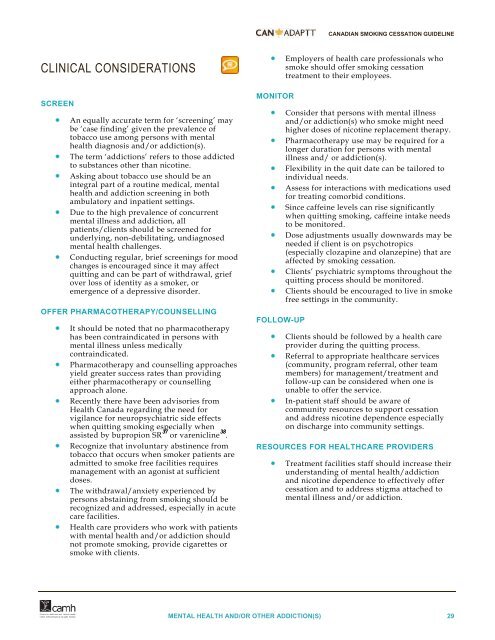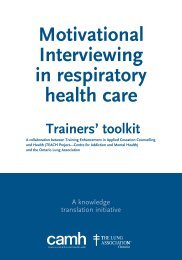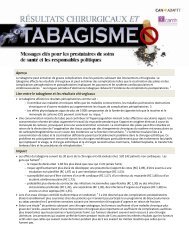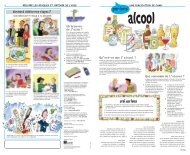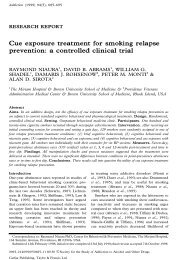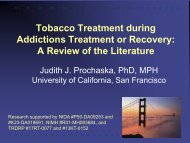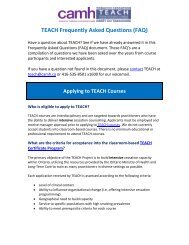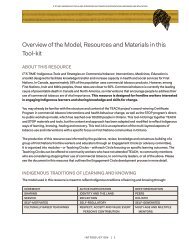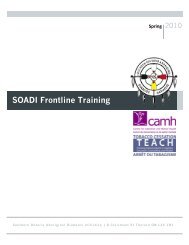Canadian Smoking Cessation Clinical Practice Guideline
Canadian Smoking Cessation Clinical Practice Guideline
Canadian Smoking Cessation Clinical Practice Guideline
Create successful ePaper yourself
Turn your PDF publications into a flip-book with our unique Google optimized e-Paper software.
CANADIAN SMOKING CESSATION GUIDELINECLINICAL CONSIDERATIONSSCREENAn equally accurate term for ‘screening’ maybe ‘case finding’ given the prevalence oftobacco use among persons with mentalhealth diagnosis and/or addiction(s).The term ‘addictions’ refers to those addictedto substances other than nicotine.Asking about tobacco use should be anintegral part of a routine medical, mentalhealth and addiction screening in bothambulatory and inpatient settings.Due to the high prevalence of concurrentmental illness and addiction, allpatients/clients should be screened forunderlying, non-debilitating, undiagnosedmental health challenges.Conducting regular, brief screenings for moodchanges is encouraged since it may affectquitting and can be part of withdrawal, griefover loss of identity as a smoker, oremergence of a depressive disorder.OFFER PHARMACOTHERAPY/COUNSELLINGIt should be noted that no pharmacotherapyhas been contraindicated in persons withmental illness unless medicallycontraindicated.Pharmacotherapy and counselling approachesyield greater success rates than providingeither pharmacotherapy or counsellingapproach alone.Recently there have been advisories fromHealth Canada regarding the need forvigilance for neuropsychiatric side effectswhen quitting smoking especially whenassisted by bupropion SR 37 or varenicline 38 .Recognize that involuntary abstinence fromtobacco that occurs when smoker patients areadmitted to smoke free facilities requiresmanagement with an agonist at sufficientdoses.The withdrawal/anxiety experienced bypersons abstaining from smoking should berecognized and addressed, especially in acutecare facilities.Health care providers who work with patientswith mental health and/or addiction shouldnot promote smoking, provide cigarettes orsmoke with clients.MONITORFOLLOW-UPEmployers of health care professionals whosmoke should offer smoking cessationtreatment to their employees.Consider that persons with mental illnessand/or addiction(s) who smoke might needhigher doses of nicotine replacement therapy.Pharmacotherapy use may be required for alonger duration for persons with mentalillness and/ or addiction(s).Flexibility in the quit date can be tailored toindividual needs.Assess for interactions with medications usedfor treating comorbid conditions.Since caffeine levels can rise significantlywhen quitting smoking, caffeine intake needsto be monitored.Dose adjustments usually downwards may beneeded if client is on psychotropics(especially clozapine and olanzepine) that areaffected by smoking cessation.Clients’ psychiatric symptoms throughout thequitting process should be monitored.Clients should be encouraged to live in smokefree settings in the community.Clients should be followed by a health careprovider during the quitting process.Referral to appropriate healthcare services(community, program referral, other teammembers) for management/treatment andfollow-up can be considered when one isunable to offer the service.In-patient staff should be aware ofcommunity resources to support cessationand address nicotine dependence especiallyon discharge into community settings.RESOURCES FOR HEALTHCARE PROVIDERSTreatment facilities staff should increase theirunderstanding of mental health/addictionand nicotine dependence to effectively offercessation and to address stigma attached tomental illness and/or addiction.MENTAL HEALTH AND/OR OTHER ADDICTION(S) 29


